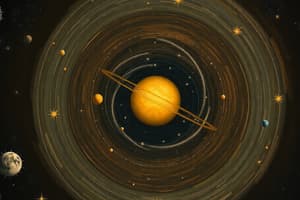Podcast
Questions and Answers
What observation did the geocentric model of the solar system help to explain?
What observation did the geocentric model of the solar system help to explain?
Retrograde motion
Which object is a gaseous giant?
Which object is a gaseous giant?
- Earth
- Y (correct)
- Venus
- Mars
Which idea was supported by Aristarchus, Copernicus, and Galileo?
Which idea was supported by Aristarchus, Copernicus, and Galileo?
The planets revolve around the Sun.
Which two gaseous giants did Renaissance scientists such as Galileo know about?
Which two gaseous giants did Renaissance scientists such as Galileo know about?
Which three scientists supported the heliocentric model of the solar system?
Which three scientists supported the heliocentric model of the solar system?
What modification did Kepler make to Copernicus's model regarding planetary orbits?
What modification did Kepler make to Copernicus's model regarding planetary orbits?
Why was it difficult for people to accept a heliocentric concept of the solar system?
Why was it difficult for people to accept a heliocentric concept of the solar system?
How did Kepler describe the planets' orbits?
How did Kepler describe the planets' orbits?
What do comets and asteroids have in common?
What do comets and asteroids have in common?
Which idea did Ptolemy's model use to explain why the planets appeared to move backward as they moved in their orbits?
Which idea did Ptolemy's model use to explain why the planets appeared to move backward as they moved in their orbits?
Flashcards are hidden until you start studying
Study Notes
Solar System Overview
- The geocentric model explains retrograde motion, where planets appear to move backward in their orbits.
- Gaseous giants in the solar system include significant planets that are predominantly made up of gases.
Key Figures and Concepts
- Aristarchus, Copernicus, and Galileo supported the heliocentric model, positing that planets revolve around the Sun.
- Renaissance scientists recognized Jupiter and Saturn as the two primary gaseous giants.
Heliocentric Model Supporters
- Three notable scientists who endorsed the heliocentric model are Kepler, Galileo, and Copernicus.
- Kepler enhanced Copernicus's model by introducing two pivotal ideas: planetary orbits are elliptical, and planets closer to the Sun move faster.
Acceptance of Heliocentrism
- Acceptance of the heliocentric model faced challenges due to the influence of Aristotle’s ideas, which were backed by religious doctrines of the time.
Orbital Characteristics
- Kepler described planetary orbits as elliptical, emphasizing the non-circular nature of these paths.
- Both comets and asteroids share a commonality: they orbit the Sun.
Ptolemaic Model
- Ptolemy’s geocentric model explained retrograde motion using epicycles, where planets follow smaller circular paths while orbiting larger circles around the Earth.
Studying That Suits You
Use AI to generate personalized quizzes and flashcards to suit your learning preferences.



